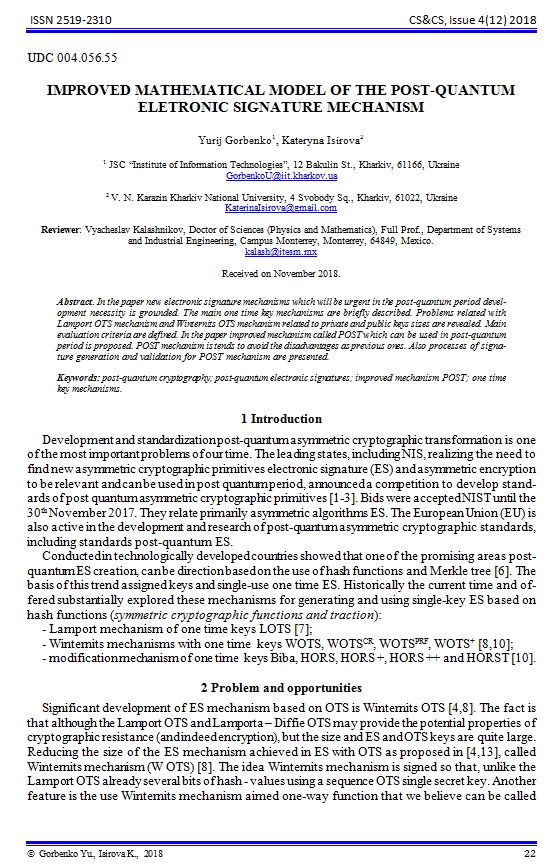Improved mathematical model of the post-quantum eletronic signature mechanism
Abstract
In the paper new electronic signature mechanisms which will be urgent in the post-quantum period development necessity is grounded. The main one time key mechanisms are briefly described. Problems related with Lamport OTS mechanism and Winternits OTS mechanism related to private and public keys sizes are revealed. Main evaluation criteria are defined. In the paper improved mechanism called POST which can be used in post-quantum period is proposed. POST mechanism is tends to avoid the disadvantages as previous ones. Also processes of signature generation and validation for POST mechanism are presented.
Downloads
References
Koblitz N. Menezes A. J. A riddle wrapped in an enigma. URL:https://eprint.iacr.org/2015/1018.pdf
Report on Post-Quatum Cryptography / Chen L. and all. NISTIR 8105 (DRAFT). URL:http://csrc.nist.gov/publications/drafts /nistir-8105/nistir_8105_draft.pdf
Mosca M. Setting the Scene for the ETSI Quantum-safe Cryptography Workshop. 1st Quantum-Safe-Crypto Workshop: E-proceedings. Sophia Antipolis, Sep. 26-27. 2013. P.25–28. URL: https://docbox.etsi.org/workshop/2013/201309_crypto/e-proceedings_crypto_2013.pdf
ETSI GR QSC 001 V.1.1.1 (2016-07). Quntum-Safe Cryptography (QSC); Quantum-safe algorithmic framework.
Post-quantum cryptography and mechanisms for its implementation / Gorbenko I.D. and all. Radiotechnics. 2016. Vol. 186. P. 32–52.
Merkle R. A certified digital signature. Advances in Cryptology - CRYPTO '89 / Gilles Brassard, editor. Springer, 1990. Vol. 3.35 of LNCS. P. 218–238.
Lamport L. Constructing digital signatures from a one way function. SRI International Computer Science Laboratory: Technical. Report SRI-CSL-98, 1979. URL:https://www.microsoft.com/en-us/research/uploads/prod/2016/12/Constructing-Digital-Signatures-from-a-One-Way-Function.pdf
Hülsing A. W-OTS + - shorter signatures for hash-based signature schemes. Progress. in Cryptology - AFRICACRYPT 2013 / A. Youssef, A. Nitaj, and A.-E. Hassanien, editors. Springer, 2012. Vol. 7918 of LNCS. P. 173–188.
SPHINCS: practical stateless hash-based Signatures. A certified digital signature / D. J. Bernstein and all. Advances in Cryptology - CRYPTO '89 / Gilles Brassard, editor. Springer, 1990. Vol. 3.35 of LNCS. P. 218–238.
SPHINCS: practical stateless hash-based Signatures / D. J. Bernstein and all. URL: djb@cr.yp.to. daira@leastauthority.com, zooko@leastauthority.com.
Gorbenko, I., Ponomar, V. Examining a possibility to use and the benefits of post-quantum algorithms dependent on the conditions of their application. EasternEuropean Journal of Enterprise Technologies. 2017. Vol. 2, Issue 9(86). P. 21–32. URL: http://journals.uran.ua/eejet/article/view/96321/93.881.12
ETSI GR QSC 001 V.1.1.1 (2016-07). Quntum-Safe Cryptography (QSC); Quantum-safe algorithmic framework.
Horbenko Yu.I., Melnyk T.V., Horbenko I.D. Analysis of potential post-quantum electronic signatures based on the hash - functions. Radiotechnics. 2017. Vol. 189. P. 115–131.
Gorbenko Yu. Methods of construction of and Analysis, standardization and application KRSM: Monograph / Ed. Gorbenko I. D. Kharkov: Fort, 2015. 958 p.
Horbenko Yu.I., Hanzya R.S. Stability analysis top cryptosystem against quantum cryptanalysis algorithm based on Grover. Data protection: Scientific journal. 2014. P. 22–28.


